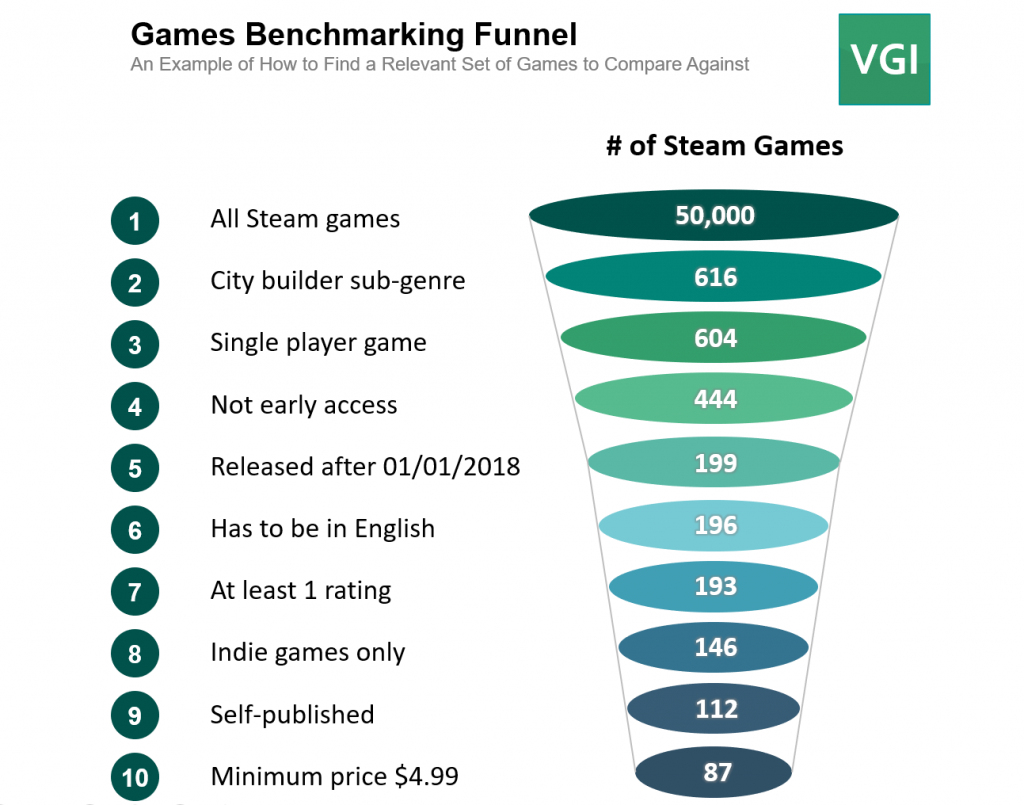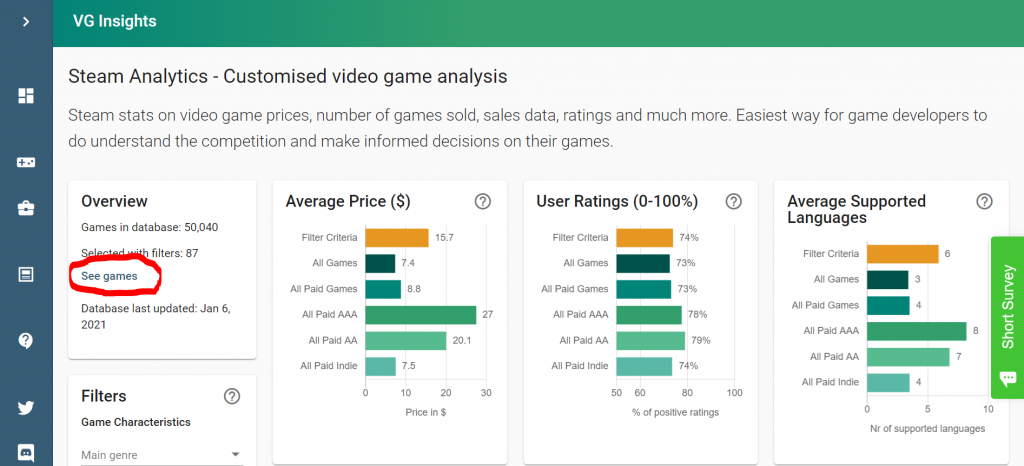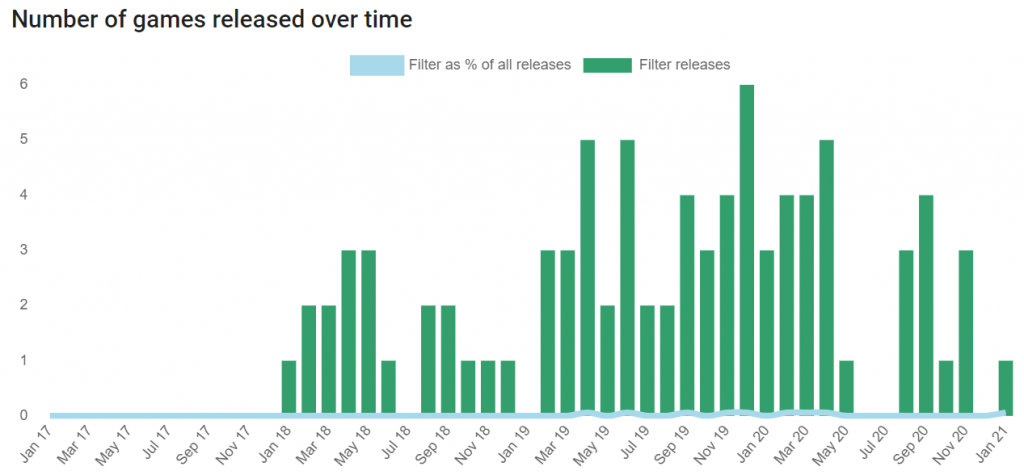What’s important when deciding which game to make?
Whether you’ve got too many or too few ideas or you just want to confirm the viability of that one idea, a structured approach will help you with finding the right answer.

Deciding which game to make does not have to be rocket science. In fact, it comes down to 2 key considerations – supply and demand.
A platformer might be fun to make, but every single indie dev has made one. Besides, there’s only about 25 people out there (most of them indie developers) who’d like to play it.
Battle Royale on the other hand is super popular, but can you really compete with Fortnite, CoD, Apax Legends, PUBG etc?
The first step should be to confirm that the proposed game has enough player interest. At the same time, you don’t want to enter an overcrowded market. Next, you’ll have to evaluate the competition, both AAA and indie. Can you bring something to the table that makes your game stand out?
Practical step-by-step guide to choosing which game to develop
In this guide, we’re using an example scenario where we want to develop a city builder simulation game. To determine the feasibility of this, we’re using the Video Game Insights free Steam Analytics tool.
You can use other sources of course, but we’ve put this platform together specifically for indie developers and makes a lot of the otherwise hard to get data available for free.
1. Selecting the right filters
The first step is to understand what type of game your idea is and which games would be the closest competitors to it.
I often hear indies saying that their game is completely unique. In the vast majority of cases, the game has some unique elements or it’s a blend of sub-genres, but it’s not as groundbreakingly innovative as they think it is. That’s good. That means you can still compare it to some existing games.
If you truly can’t find any comparable games, that’s a cause to worry rather than something to be proud about. There’s a chance you’re a genius. There’s also a chance that nothing like that has ever been made before for a reason.
We start on the Steam Analytics page. (picture below) To determine the right games to compare to, we have to apply some filters. (We start with over 50,000 games as of January 2021)

Game Characteristics
- Genres and sub-genres – The most important factor to narrow your search is the sub-genre. In our example, we pick a city builder game. (We’re immediately down to only 616 games)
- Game mode – it’s a single player game and we won’t add multi-player to keep it simpler. (Down to 604 games)
Release and Performance
- Release type – It’s going to be a full game, not early access. (444 games)
- Release date – We only care about the newer games as the industry changes quickly, so we set the release date to start from 2018. (199 games)
- Language – Our game is mainly for the western market, so it has to have at least English language. (196 games)
- Minimum raters count – We only include games with at least 1 rating to remove the low quality and hobby games. (193 games)
Publisher Overview
- Publisher classification – We only care about indie games. AAA and AA would distort our results. (146 games)
- Publishing – We only include self-published games only as that’s what we plan to do with our game. (112 games)
Business Model
- Minimum price – We’ll set that to $4.99 as we don’t want to include free and very cheap games. (87 games)

We have now funneled down the list from over 50,000 games to just under 100. That’s a perfect sample size for our purposes – large enough to give us some statistical rigour, but targeted enough to focus on our specific game idea.
To sense check this, we click ‘See games’ under the overview section. This opens up a list of actual games that fit those filters.

The first check is that these games are all in fact fitting our criteria – eg they are city builders with the right price range etc. Open some Steam pages and check whether the games look in any way similar to what we’d make.
The list is automatically sorted by number of ratings, so we’re starting with the most popular of these games.
The first game in the list is ‘They are Billions’ – a steampunk colony builder – sounds relevant. ISLANDERS is a city builder on… an island. Again, it’s the right type of game. Dawn of Man is building cave man villages.

Okay, feels like we’ve got this right. The basic game mechanics are all similar to what we’re planning to do.
2. Determining if the type of game has been overproduced by other developers
We will now go back to the Steam Analytics page (your filters will be saved) and check the ‘# of games released over time’ graph. There were typically between 3-5 city builder games like that released per month in 2019. That’s decent competition, but compared to other sub-genres it’s actually quite low. For example, in the second half of 2020, about 100 platformer games were released each month.

3. Determining which games are in demand and popular among players
To understand how popular the game is, we will have to look at how the competing games have been rated and, more importantly, how many units they’ve managed to sell.
Firstly, the benchmarked games, on average, get a rating of 74%, pretty much in line with other types of games. So they’re not necessarily better games.
However, prices for these games are, on average, $15.7, much higher than the overall average of $7.5. Nearly half of these games are priced between $10 and $20. That might be a good range to initially consider for your own game.

The next section to use is the average sales / average units sold graph. This gives you an idea of how commercially successful games like this have been.

A typical game on Steam sells about 1,000 copies. City builders sell almost 6,000 – way more. There is a higher demand for games like this. Indies can provide good quality games in that space. This, together with the higher price also leads to significantly higher revenues for the developers.
The revenue distribution graph shows that only 14% of the games have made less than $5k in their lifetime. That’s really promising as over half of all games on Steam never make $5k.
In fact, more than half of the city builder indie games make over $60k. Almost 1 in 5 games like that make over $1 million. These numbers are huge compared to normal indies, making this sub-genre incredibly appealing.
Another way to check the popularity of games is to see which games are trending on Steam or other platforms. What are people talking about in the social media? Are there any standout games that have recently brought a lot of attention to that specific sub-genre?
Finally, we go back to the games list by clicking ‘see games’ under the overview section. We sort the games by # of ratings to see which games in the category have had most success.
You can then use the Steam pages to look at the gameplay specifics, graphics, user reviews and get much more detail around what specifically makes the successful games in that genre stand out.

Should I consider making this game?
We’ve done about 15 minutes of research at this point. Yet, we already know so much more about the game we are considering making. It’s not a fully quantitative approach and never should be. It’s not a ‘yes/no’ answer, but it does say that games like this are popular, but aren’t overproduced.
Of course, you can now spend more time on the platform and dig deeper before making the decision. You could try out other sub-genres and see if they work better.
You could also do other forms of research. For example, you could do a simple survey and distribute that to your gamer friends to gauge their interest. You could also do a more in-depth analysis of the success stories in your chosen category.
The good thing is that you’re now well on a path of making better educated decisions.
If you found this insightful, you might want to check out more games industry trends on our free Steam Analytics platform or explore data on any individual game or publisher!